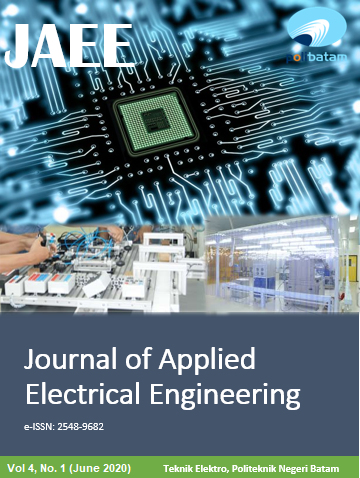Analisis Pengaruh Penggunaan Mesin Peniris Gorengan Terhadap Kualitas Gorengan
DOI:
https://doi.org/10.30871/jaee.v4i1.2090Keywords:
Gorengan, penirisan, machineAbstract
Minyak goreng yang tersimpan dalam jumlah banyak pada gorengan akan meningkatkan risiko masalah kesehatan sehingga diperlukan teknik untuk mengeluarkan minyak goreng yang berlebihan pada gorengan. Teknik yang dapat dilakukan adalah dengan menggunakan penirisan manual dan dengan menggunakan mesin peniris otomatis. Penggunaan dua teknik tersebut akan dianalisis melalui penelitian ini. Metode yang digunakan pada penelitian ini terdiri atas persiapan gorengan yang akan digunakan, persiapan peniris gorengan, pengujian sistem dan penimbangan massa gorengan. Dengan membandingkan bakwan, tahu dan tempe, diperoleh kesimpulan bahwa jenis gorengan yang memiliki persentase penurunan massa tertinggi dimiliki oleh gorengan bakwan dengan nilai persentase sekitar 10%. Jenis kecepatan mesin high speed memberikan persentase penurunan massa paling tinggi untuk semua jenis kecepatan dengan nilai persentase penurunan massa sekitar 10%. Setelah proses penirisan, semua jenis gorengan memiliki kualitas yang baik karena tidak mengalami kerusakan, baik berupa sobek, patah, maupun pecah.
Downloads
References
Y. Hanum, "DAMPAK BAHAYA MAKANAN GORENGAN BAGI JANTUNG," J. Kel. SEHAT Sejah., vol. 14, no. 2, Dec. 2016, doi: 10.24114/jkss.v14i28.4700.
S. D. Ardhany and L. Lamsiyah, "Tingkat Pengetahuan Pedagang Warung Tenda di Jalan Yos Sudarso Palangkaraya tentang Bahaya Penggunaan Minyak Jelantah bagi Kesehatan," J. Surya Med., vol. 3, no. 2, pp. 62"“68, Feb. 2018, doi: 10.33084/jsm.v3i2.99.
M. Adriana and R. Syahyuniar, "RANCANG BANGUN ALAT PENIRIS MINYAK PADA KERIPIK SINGKONG," Elem. J. Tek. MESIN, vol. 6, p. 20, Jun. 2019, doi: 10.34128/je.v6i1.90.
A. Thoriq, T. Herwanto, and D. Ciptaningtyas, "MODIFIKASI MESIN PENIRIS MINYAK DAN KELAYAKAN FINANSIAL PRODUKSI KERIPIK BAYAM," J. Tek. Pertan. Lampung J. Agric. Eng., vol. 7, p. 63, Aug. 2018, doi: 10.23960/jtep-l.v7i2.63-71.
S. Wasisto, I. L. I. Purnama, and P. W. Anggoro, "PERANCANGAN MESIN PENIRIS UNTUK ANEKA MAKANAN RINGAN HASIL GORENGAN," p. 9, 2016.
W. K. Sugandi, A. M. Kramadibrata, F. Fetriyuna, and Y. Prabowo, "Analisis Teknik dan Uji Kinerja Mesin Peniris Minyak (Spinner) (Technical Analysis and Test Performance of Oil Spinner Machine)," J. Ilm. Rekayasa Pertan. Dan Biosist., vol. 6, no. 1, pp. 17"“26, Mar. 2018, doi: 10.29303/jrpb.v6i1.65.
I. Irdam, D. Setiawan, A. Irmayanti, and A. Aditya, "Rancang Bangun Mesin Peniris Minyak," Din. J. Ilm. Tek. Mesin, vol. 11, p. 77, May 2020, doi: 10.33772/djitm.v11i2.11799.
Downloads
Published
How to Cite
Issue
Section
License
Authors who publish with this journal agree to the following terms:
- Authors retain copyright and grant the journal right of first publication with the work simultaneously licensed under a Creative Commons Attribution License (Attribution-ShareAlike 4.0 International (CC BY-SA 4.0) ) that allows others to share the work with an acknowledgment of the work's authorship and initial publication in this journal.
- Authors are able to enter into separate, additional contractual arrangements for the non-exclusive distribution of the journal's published version of the work (e.g., post it to an institutional repository or publish it in a book), with an acknowledgment of its initial publication in this journal.
- Authors are permitted and encouraged to post their work online (e.g., in institutional repositories or on their website) prior to and during the submission process, as it can lead to productive exchanges, as well as earlier and greater citation of published work (See The Effect of Open Access).
Open Access Policy
This journal provides immediate open access to its content on the principle that making research freely available to the public supports a greater global exchange of knowledge. Its free availability on the public internet, permitting any users to read, download, copy, distribute, print, search, or link to the full texts of these articles, crawl them for indexing, pass them as data to software, or use them for any other lawful purpose, without financial, legal, or technical barriers other than those inseparable from gaining access to the internet itself.















